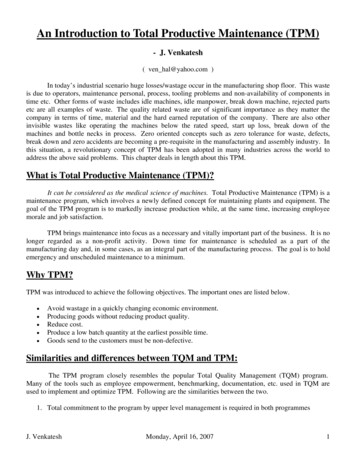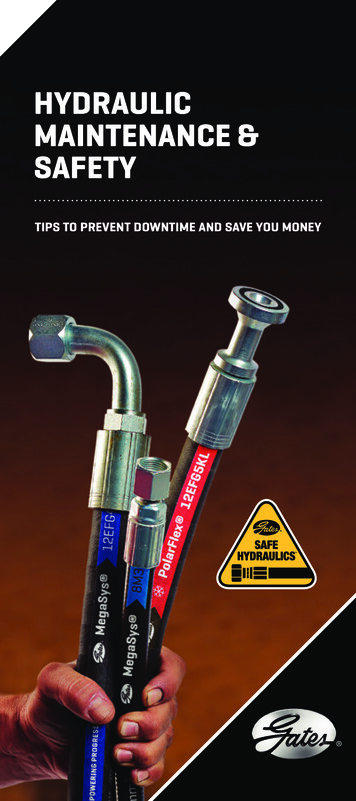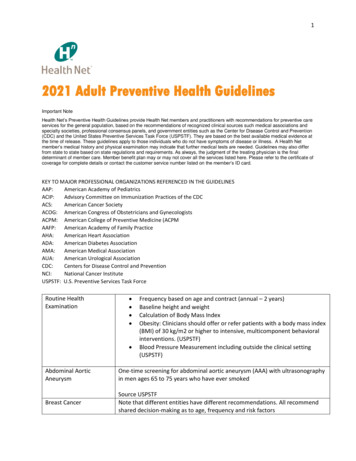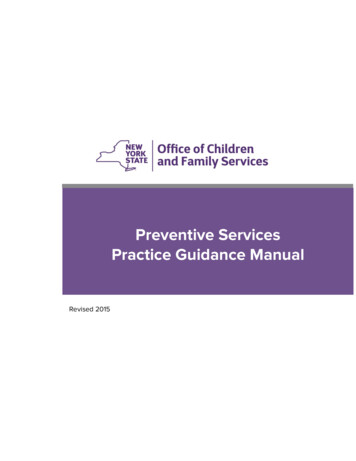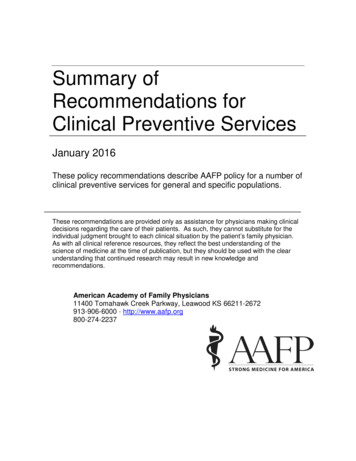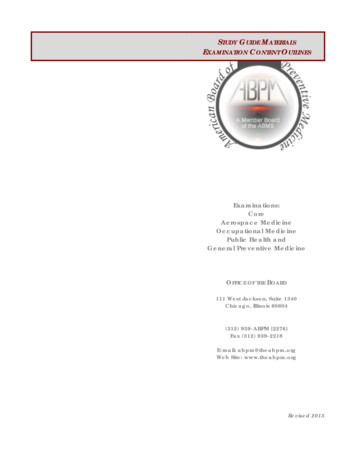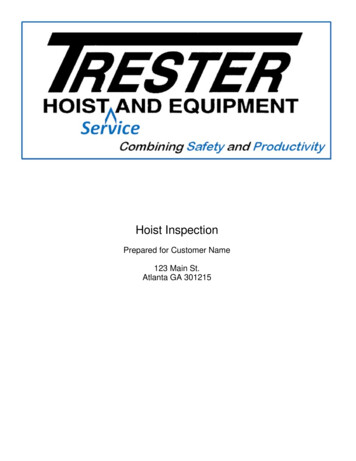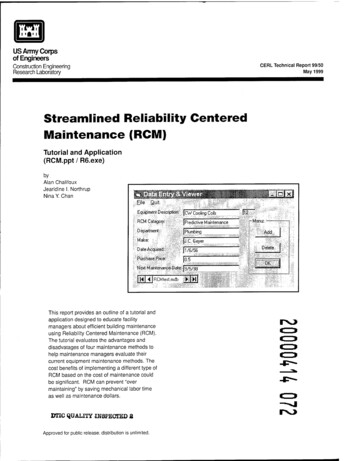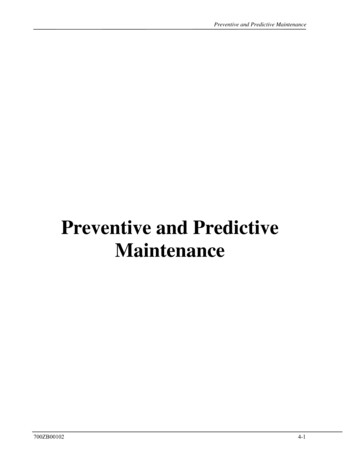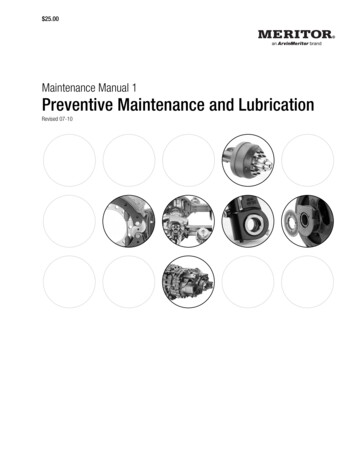
Transcription
25.00Maintenance Manual 1Preventive Maintenance and LubricationRevised 07-10
Service NotesAbout This ManualLiterature on Demand (LODonDVD)This manual provides maintenance intervals and procedures,lubricant specifications, and product capacities for Meritorcomponents.The LODonDVD contains product, service and warranty informationfor ArvinMeritor components. To order the DVD, visit Literature onDemand at arvinmeritor.com and specify TP-0742.Before You BeginHow to Obtain Tools and SuppliesSpecified in This Manual1.Read and understand all instructions and procedures beforeyou begin to service components.2.Read and observe all Warning and Caution hazard alertmessages in this publication. They provide information that canhelp prevent serious personal injury, damage to components,or both.3.Follow your company’s maintenance and service, installation,and diagnostics guidelines.4.Use special tools when required to help avoid serious personalinjury and damage to components.Call ArvinMeritor’s Commercial Vehicle Aftermarket at888-725-9355 to obtain Meritor tools and supplies.Hazard Alert Messages and TorqueSymbolsWARNINGA Warning alerts you to an instruction or procedure that youmust follow exactly to avoid serious personal injury anddamage to components.CAUTIONA Caution alerts you to an instruction or procedure that youmust follow exactly to avoid damage to components.@ This symbol alerts you to tighten fasteners to a specified torquevalue.How to Obtain Additional Maintenanceand Service InformationOn the WebVisit Literature on Demand at arvinmeritor.com to access and orderproduct, service, aftermarket, and warranty literature forArvinMeritor’s truck, trailer and specialty vehicle components.Information contained in this publication was in effect at the time the publication wasapproved for printing and is subject to change without notice or liability. Meritor HeavyVehicle Systems, LLC, reserves the right to revise the information presented or todiscontinue the production of parts described at any time.ArvinMeritor Maintenance Manual 1 (Revised 07-10)
Contentspg. i124Asbestos and Non-Asbestos FibersSection 1: IntroductionOverviewRegularly-Scheduled MaintenanceOil LubricantsViscosityOil Change SchedulesOil Drain ConditionsNational Lubricating Grease Institute (NLGI) StandardsExtreme Pressure (EP) Lubricants1516171819202425Section 3: Clutches89121314262728293134Release BearingClutch HousingLinkageLubrication Intervals and SpecificationsTroubleshootingSpecial Tools35Section 4: Drivelines48Technical PublicationsHow to Obtain Additional Maintenance and ServiceInformationDescriptionRPL Series Permalube (Non-Greaseable)Wing-Style Permalube Full-Round, Easy Service , Wing-Style and 155R eEnd YokesUniversal JointsCenter BearingsSlip YokeUniversal Joint CapscrewsLubricationXtended Lube MXL 17N, 176N and 18N Series Drivelines(Full Round)Universal JointSlip Yoke SplinesRPL Series Permalube Driveline Universal Joint, Slip Yokeand SplinesStandard/Conventional Driveline Universal JointStandard/Conventional Driveline Slip Yoke and SplinesWing-Style Permalube Driveline Universal JointWing-Style Greaseable Driveline Universal JointWing-Style Permalube and Greaseable Driveline Slip Yokeand SplinesIntervalsInspection and MaintenanceLubrication Intervals and SpecificationsLubrication Intervals for Xtended Lube MXL SeriesDrivelinesTroubleshooting51Section 5: Front Drive Steer Axles52Technical PublicationsHow to Obtain Additional Maintenance and ServiceInformationDescriptionFront Drive Steer AxlesIdentificationModel NomenclatureFront Drive Steer AxlesFront Drive Steer Axles, Prior ModelsInspectionSteering-Related ComponentsSection 2: Bus and CoachTechnical PublicationsHow to Obtain Additional Maintenance and ServiceInformationDescriptionFront AxlesRear AxlesCenter AxlesImportant InformationCam BrakesImportant InformationStopmaster Wedge BrakesDiscPlus BrakesT Series Parking BrakeIdentificationModel NomenclatureInspectionFront AxlesLubricationKing Pin BushingsTie RodGrease-Lubricated Wheel BearingsOil-Lubricated Wheel BearingsRear AxlesInverted Portal Drive AxlePlanetary Drive AxlesCam BrakesT Series Parking BrakeStopmaster BrakesLubrication Intervals and SpecificationsStopmaster Wedge Brakes5pg. 2930Technical PublicationsHow to Obtain Additional Maintenance and ServiceInformationDescriptionIdentificationModel NomenclatureInspectionWhen to Inspect the ClutchClutch LinkageInternal Parts of the ClutchLubrication36373839404142434446475456
Contentspg. 5668Steering Knuckle Vertical End PlayUpper and Lower Knuckle BushingsTie Rod EndsServicing the Tie Rod EndsWhy It’s Important to Inspect the Tie Rod Ends for Wear andAllowable Movement at the Regularly-Scheduled IntervalsTie Rod Assembly MovementSteering Arm BoltsSealed Hub UnitsCarrierCheck and Adjust the Oil LevelDrain and Replace the OilLubricationKing Pin BushingsCamshaft Retainer Bushing and Cam BushingCross Tube End AssemblyDrive Axle Shaft Universal JointsAxle Shaft Spline and Thrust WasherKnuckle BushingWheel BearingsTie Rod EndSteering Knuckle SocketsLubrication Intervals and SpecificationsTroubleshooting70Section 6: Front Non-Drive Steer ow to Obtain Additional Maintenance and ServiceInformationDescriptionIdentificationModel NomenclatureInspectionPartsSteering Knuckle Vertical End PlayUpper and Lower King Pin BushingsUnitized Wheel EndTie Rod and Cross Tube AssemblyDepartment of Transportation Roadside Tie Rod AssemblyReplacement CriteriaLubricationTie Rod EndKing Pin BushingsBall Studs on the Steering Arm and the Tie Rod Arm EndsGrease-Lubricated Wheel BearingsOil-Lubricated Wheel BearingsCheck and AdjustSteering Arm BoltsTighten Draw Key NutsLubrication Intervals and SpecificationsLubricantTroubleshooting90Section 7: Brakes91Cam BrakesTechnical PublicationsDescriptionIdentificationpg. 115116117Model NomenclatureImportant InformationCam Brake Inspection Intervals and ProceduresOn-Highway Linehaul ApplicationsOff-Highway Linehaul ApplicationsQ Plus LX500 and MX500 Cam Brakes with AutomaticSlack AdjustersDo Not Lubricate the LX500 and MX500 Brakes andAutomatic Slack Adjuster Before the Specified Time orMileage IntervalsInspection ProcedureCam Brakes, All ModelsImportant InformationCommercial Vehicle Safety Alliance (CVSA) GuidelinesCam Brake Lubrication Intervals and ProceduresQ Plus LX500 and MX500 Cam Brakes and AutomaticSlack Adjusters After the Specified Time or MileageIntervalsCam Brake TipsApproved LubricantsImportant InformationCam Brake TroubleshootingDiagnostic ChartsAir Disc BrakesTechnical PublicationsDescriptionFeaturesIdentificationAir Disc Brake Inspection Intervals and ProceduresInspection SchedulesImportant InformationCommercial Vehicle Safety Alliance (CVSA) GuidelinesImportant InformationChecking the Adjusted Chamber Stroke Length onDiscPlus DX195 and DX225 Air Disc BrakesDiscPlus DX195 and DX225 Air Disc Brake ComponentsAir Disc Brake Model ADB 1560 Lubrication Intervals andProceduresLubrication ProceduresApproved LubricantsImportant InformationAir Disc Brake TroubleshootingBrake Diagnostic ChartsImportant InformationDiscPlus DX195 and DX225 Air Disc BrakesAutomatic Slack AdjustersImportant InformationTechnical PublicationsIntervalsIdentificationProceduresAt Brake RelineApproved LubricantsAnti-Seize CompoundImportant InformationAutomatic Slack Adjuster Troubleshooting
Contentspg. 117 Diagnostic Charts118 Wedge BrakesTechnical PublicationsDescriptionIdentification119 Important InformationBrake Adjustment ProcedureInspection Procedure120 Lubrication121 Approved LubricantsImportant InformationWedge Brake TroubleshootingDiagnostic Charts124 Four-Piston Quadraulic Disc BrakesTechnical PublicationsDescriptionIdentification125 Four-Piston Quadraulic Disc Brake InspectionBleeding the Brake System126 Four-Piston Quadraulic Disc Brake TroubleshootingDiagnostic Charts128 DuraPark Hydraulic Drum BrakesTechnical PublicationsDescriptionDuraPark Hydraulic Brake Product Update129 Adjustment Procedures130 Brake Drums and RotorsTechnical PublicationsBrake Drum Inspection and Failure Analysis131 Brake Drum Wear InspectionClean the Mounting Surfaces132 Brake Drum Procedures133 Brake Drum Wear Conditions137 Conditions That Can Affect Brake Drum Wear138 Brake Drum Diagnostics140 RotorsRotor Wear InspectionMeasuring the Thickness of the Rotor or Disc141143145146147148pg. 148149150151155156Section 9: Suspensions166Technical PublicationsHow to Obtain Additional Maintenance and ServiceInformationRideStarTM RHP Series Trailer Air Suspension SystemsSingle-Axle SystemSliding Tandem SystemInspectionSingle-Axle and Sliding Tandem SuspensionsMaintenanceSingle-Axle and Sliding Tandem SuspensionsUpper Control Arm Bushing Periodic Inspection Guidelines:All RideStar RHP Series Trailer Air Suspension SystemsSlider on Sliding Tandem Suspension SystemRideStarTM RFS Series Trailer Air Suspension SystemRide HeightTire ClearanceMaintenanceInspect the Shock Absorbers169Section 10: Trailer Axles157158159160161162164Section 8: Rear Drive AxlesTechnical PublicationsHow to Obtain Additional Maintenance and ServiceInformationDescriptionIdentificationModel NomenclatureAxle Model Numbers and DesignationsInspectionCarrierOil SealsSeal Test ProcedureExample 1: The Seal is not LeakingExample 2: The Seal Appears to be LeakingExample 3: The Seal is LeakingLubricationAdvanced Lube AxlesR-170 Axles Equipped with Traction Equalizer Limited Slip Friction ModifiersFill Plug LocationsCheck and Adjust the Oil LevelDrain and Replace the OilInter-Axle Assemblies with Separate HousingsLubrication Intervals and SpecificationsLubrication Analysis RecommendationsTroubleshootingAll Rear Axles170171172174Important InformationTechnical PublicationsHow to Obtain Additional Maintenance and ServiceInformationDescriptionAxle ModelsAxle DesignsTB Series Trailer Axles with Unitized Wheel-End AssembliesHow to Identify Trailer Axles with Unitized Wheel EndsHow to Find the Model Number, Serial Number and Date ofManufactureWhat the Numbers MeanModel NumberSerial NumberDate of ManufactureModel NomenclatureCurrent Production Model NumbersSection 11: Transfer CasesTechnical PublicationsHow to Obtain Additional Maintenance and ServiceInformationDescription
Contentspg. 174 Identification175 Model Nomenclature176 Lubricant TemperaturesMeritor MTC-4208, MTC-4209 and MTC-4210 SeriesTransfer CasesOther Meritor Transfer CasesDo Not Install API GL-5 OilsInspectionMagnets and Magnetic Drain Plugs177 Operating InformationBreatherSealsCheck and Adjust the Oil Level178 Drain and Replace the OilTransfer Case OilIntervalsTowing Procedures179 SpecificationsCapacities180 Troubleshooting186187188189190191192193Section 12: TransmissionsTechnical PublicationsHow to Obtain Additional Maintenance and ServiceInformationDescriptionManual TransmissionsEngine Synchro Shift (ESS ) Transmission Shift SystemSureShift TransmissionZF-FreedomLine TransmissionIdentificationModel NomenclatureIntervalsEvery 10,000 Miles (16 000 km) of Vehicle OperationEvery 50,000 Miles (80 000 km) of Vehicle Operation(Approved Petroleum Base and Heavy-Duty Engine Oils)Every 500,000 Miles (400 000 km) of Vehicle Operation(Approved Full-Synthetic Oils)InspectionOil Drain ConditionsMagnets and Magnetic Drain PlugsTransmission Oil CoolersTemperature IndicatorCheck and Adjust the Oil LevelInspectionBreather Vent ConditionFastener TorqueInspecting the Transmission for Leaks and DamageDrain and Replace the OilTransmission OilAdjustmentLinkage for the Remote Control AssemblyLubricationRemote Control AssemblyZF-FreedomLine Clutch ForkLubrication Intervals and Specificationspg. 193 Approved Oil194 TroubleshootingOn Manual TransmissionsOil LeaksOn New TransmissionsVibration195 NoiseOperation ProblemsTroubleshooting Leaks196 Troubleshooting Vibrations197 Troubleshooting Noises198 Troubleshooting Operating Conditions201Section 13: Wheel Bearings and Wheel Ends231Technical PublicationsHow to Obtain Additional Maintenance and ServiceInformationConventional Wheel EndsDescriptionModel NomenclatureOil-Lubricated Wheel BearingsGrease-Lubricated Wheel BearingsImportant InformationLong-Life Wheel EndsFront Non-Drive Steer Axles with Unitized HubsIdentificationModel NomenclatureInspection ProcedureInspection IntervalsTools RequiredBasic InspectionDetailed InspectionReplacement Hub InspectionInstall the Spindle O-Rings and HubcapsUnitized Wheel Ends on Bus and Coach FH Series Front andTag Axles, and MC Series Rear Drive AxlesInspectionDisassemble the Unitized Wheel EndTrailer Axles with Long-Life Wheel EndsModel NomenclatureTB Series Trailer Axles with Unitized Hub AssembliesTL Series Trailer Axles with Packaged Bearing HubAssembliesTrailer Lubrication Intervals and SpecificationsTRIAD Trailer Axle Wheel-End SystemWheel-End Equipment ChecksStuds and NutsInstalling Double-Ended Metric Wheel Studs with 3/4-16and M22 x 1.5 Threads Onto Hub and Rotor Assemblieson Axles Equipped with Meritor Air Disc Brake Model ADB1560Vehicles Equipped with ABS232Section 14: Specifications233Lubrication Intervals and SpecificationsGrease LubricantsOil 24226230
Asbestos and Non-Asbestos FibersFigure 0.1ASBESTOS FIBERS WARNINGNON-ASBESTOS FIBERS WARNINGThe following procedures for servicing brakes are recommended to reduce exposure toasbestos ber dust, a cancer and lung disease hazard. Material Safety Data Sheets areavailable from ArvinMeritor.The following procedures for servicing brakes are recommended to reduce exposure tonon-asbestos ber dust, a cancer and lung disease hazard. Material Safety DataSheets are available from ArvinMeritor.Hazard SummaryHazard SummaryBecause some brake linings contain asbestos, workers who service brakes must understand thepotential hazards of asbestos and precautions for reducing risks. Exposure to airborne asbestosdust can cause serious and possibly fatal diseases, including asbestosis (a chronic lung disease)and cancer, principally lung cancer and mesothelioma (a cancer of the lining of the chest orabdominal cavities). Some studies show that the risk of lung cancer among persons who smokeand who are exposed to asbestos is much greater than the risk for non-smokers. Symptoms ofthese diseases may not become apparent for 15, 20 or more years after the rst exposure toasbestos.Most recently manufactured brake linings do not contain asbestos bers. These brake linings maycontain one or more of a variety of ingredients, including glass bers, mineral wool, aramid bers,ceramic bers and silica that can present health risks if inhaled. Scientists disagree on the extentof the risks from exposure to these substances. Nonetheless, exposure to silica dust can causesilicosis, a non-cancerous lung disease. Silicosis gradually reduces lung capacity and ef ciencyand can result in serious breathing dif culty . Some scientists believe other types of non-asbestosbers, when inhaled, can cause similar diseases of the lung. In addition, silica dust and ceramicber dust are known to the State of California to cause lung cancer . U.S. and internationalagencies have also determined that dust from mineral wool, ceramic bers and silica are potentialcauses of cancer.Accordingly, workers must use caution to avoid creating and breathing dust when servicingbrakes. Speci c recommended work practices for reducing exposure tonon-asbestos dust follow. Consult your employer for more details.Accordingly, workers must use caution to avoid creating and breathing dust when servicingbrakes. Speci c recommended work practices for reducing exposure to asbestos dust follow .Consult your employer for more details.Recommended Work Practices1. Separate Work Areas. Whenever feasible, service brakes in a separate area away from otheroperations to reduce risks to unprotected persons. OSHA has set a maximum allowable level ofexposure for asbestos of 0.1 f/cc as an 8-hour time-weighted average and 1.0 f/cc averaged overa 30-minute period. Scientists disagree, however, to what extent adherence to the maximumallowable exposure levels will eliminate the risk of disease that can result from inhaling asbestosdust. OSHA requires that the following sign be posted at the entrance to areas where exposuresexceed either of the maximum allowable levels:DANGER: ASBESTOSCANCER AND LUNG DISEASE HAZARDAUTHORIZED PERSONNEL ONLYRESPIRATORS AND PROTECTIVE CLOTHINGARE REQUIRED IN THIS AREA.2. Respiratory Protection. Wear a respirator equipped with a high-ef ciency (HEP A) lterapproved by NIOSH or MSHA for use with asbestos at all times when servicing brakes, beginningwith the removal of the wheels.3.a.Procedures for Servicing Brakes.Enclose the brake assembly within a negative pressure enclosure. The enclosure should beequipped with a HEPA vacuum and worker arm sleeves. With the enclosure in place, use theHEPA vacuum to loosen and vacuum residue from the brake parts.b. As an alternative procedure, use a catch basin with water and a biodegradable, nonphosphate, water-based detergent to wash the brake drum or rotor and other brake parts.The solution should be applied with low pressure to prevent dust from becoming airborne.Allow the solution to ow between the brake drum and the brake support or the brake rotorand caliper. The wheel hub and brake assembly components should be thoroughly wetted tosuppress dust before the brake shoes or brake pads are removed. Wipe the brake partsclean with a cloth.c. If an enclosed vacuum system or brake washing equipment is not available, employers mayadopt their own written procedures for servicing brakes, provided that the exposure levelsassociated with the employer’s procedures do not exceed the levels associated with theenclosed vacuum system or brake washing equipment. Consult OSHA regulations for moredetails.d. Wear a respirator equipped with a HEPA lter approved by NIOSH or MSHA for use withasbestos when grinding or machining brake linings. In addition, do such work in an area witha local exhaust ventilation system equipped with a HEPA lter .e. NEVER use compressed air by itself, dry brushing, or a vacuum not equipped with a HEPAlter when cleaning brake parts or assemblies. NEVER use carcinogenic solvents,ammable solvents, or solvents that can damage brake components as wetting agents.4. Cleaning Work Areas. Clean work areas with a vacuum equipped with a HEPA lter or by wetwiping. NEVER use compressed air or dry sweeping to clean work areas. When you emptyvacuum cleaners and handle used rags, wear a respirator equipped with a HEPA lter approvedby NIOSH or MSHA for use with asbestos. When you replace a HEPA lter , wet the lter with a nemist of water and dispose of the used lter with care.5. Worker Clean-Up. After servicing brakes, wash your hands before you eat, drink or smoke.Shower after work. Do not wear work clothes home. Use a vacuum equipped with a HEPA lter tovacuum work clothes after they are worn. Launder them separately. Do not shake or usecompressed air to remove dust from work clothes.6. Waste Disposal. Dispose of discarded linings, used rags, cloths and HEPA lters with care,such as in sealed plastic bags. Consult applicable EPA, state and local regulations on wastedisposal.Regulatory GuidanceReferences to OSHA, NIOSH, MSHA, and EPA, which are regulatory agencies in the United States,are made to provide further guidance to employers and workers employed within the UnitedStates. Employers and workers employed outside of the United States should consult theregulations that apply to them for further guidance.Recommended Work Practices1. Separate Work Areas. Whenever feasible, service brakes in a separate area away from otheroperations to reduce risks to unprotected persons.2. Respiratory Protection. OSHA has set a maximum allowable level of exposure for silica of 0.1mg/m3 as an 8-hour time-weighted average. Some manufacturers of non-asbestos brake liningsrecommend that exposures to other ingredients found in non-asbestos brake linings be keptbelow 1.0 f/cc as an 8-hour time-weighted average. Scientists disagree, however, to what extentadherence to these maximum allowable exposure levels will eliminate the risk of disease that canresult from inhaling non-asbestos dust.Therefore, wear respiratory protection at all times during brake servicing, beginning with theremoval of the wheels. Wear a respirator equipped with a high-ef ciency (HEP A) lterapproved by NIOSH or MSHA, if the exposure levels may exceed OSHA or manufacturers’recommended maximum levels. Even when exposures are expected to be within the maximumallowable levels, wearing such a respirator at all times during brake servicing will help minimizeexposure.3. Procedures for Servicing Brakes.a.Enclose the brake assembly within a negative pressure enclosure. The enclosure should beequipped with a HEPA vacuum and worker arm sleeves. With the enclosure in place, use theHEPA vacuum to loosen and vacuum residue from the brake parts.b. As an alternative procedure, use a catch basin with water and a biodegradable, nonphosphate, water-based detergent to wash the brake drum or rotor and other brake parts.The solution should be applied with low pressure to prevent dust from becoming airborne.Allow the solution to ow between the brake drum and the brake support or the brake rotorand caliper. The wheel hub and brake assembly components should be thoroughly wetted tosuppress dust before the brake shoes or brake pads are removed. Wipe the brake partsclean with a cloth.c. If an enclosed vacuum system or brake washing equipment is not available, carefully cleanthe brake parts in the open air. Wet the parts with a solution applied with a pump-spraybottle that creates a ne mist. Use a solution containing water, and, if available, abiodegradable, non-phosphate, water-based detergent. The wheel hub and brake assemblycomponents should be thoroughly wetted to suppress dust before the brake shoes or brakepads are removed. Wipe the brake parts clean with a cloth.d. Wear a respirator equipped with a HEPA lter approved by NIOSH or MSHA when grinding ormachining brake linings. In addition, do such work in an area with a local exhaust ventilationsystem equipped with a HEPA lter .e. NEVER use compressed air by itself, dry brushing, or a vacuum not equipped with a HEPAlter when cleaning brake parts or assemblies. NEVER use carcinogenic solvents,ammable solvents, or solvents that can damage brake components as wetting agents.4. Cleaning Work Areas. Clean work areas with a vacuum equipped with a HEPA lter or by wetwiping. NEVER use compressed air or dry sweeping to clean work areas. When you emptyvacuum cleaners and handle used rags, wear a respirator equipped with a HEPA lter approvedby NIOSH or MSHA, to minimize exposure. When you replace a HEPA lter , wet the lter with ane mist of water and dispose of the used lter with care.5. Worker Clean-Up. After servicing brakes, wash your hands before you eat, drink or smoke.Shower after work. Do not wear work clothes home. Use a vacuum equipped with a HEPA lter tovacuum work clothes after they are worn. Launder them separately. Do not shake or usecompressed air to remove dust from work clothes.6. Waste Disposal. Dispose of discarded linings, used rags, cloths and HEPA lters with care,such as in sealed plastic bags. Consult applicable EPA, state and local regulations on wastedisposal.Regulatory GuidanceReferences to OSHA, NIOSH, MSHA, and EPA, which are regulatory agencies in the United States,are made to provide further guidance to employers and workers employed within the UnitedStates. Employers and workers employed outside of the United States should consult theregulations that apply to them for further guidance.ArvinMeritor Maintenance Manual 1 (Revised 07-10)i
11 IntroductionOverview1 IntroductionThis manual provides maintenance and lubrication information forMeritor-produced components, including inspection and serviceintervals, procedures, grease and oil specifications and productcapacities. Troubleshooting information is also provided to assist indiagnosing customer concerns. Following these guidelines willenable you to correctly lubricate and maintain components, andcorrect issues to help ensure maximum component life.ViscosityCAUTIONUse the correct viscosity lubricants. Do not lower the viscosityof lubricants by adding thinning agents, such as kerosene,gasoline or other dilutents. Damage to components will result.앫 Always follow recommended maintenance intervals andprocedures.Select the correct viscosity oil for a specific component from thetables in each section of this manual. When more than one lubricantis listed, choose an oil viscosity that is suitable for the expectedoutside temperature.앫 Always use the specified oil or grease lubricant from amanufacturer that provides quality products and completeapplication instructions.Oil viscosity grades and classifications are provided by the Societyof Automotive Engineers (SAE) and the American Petroleum Institute(API).To obtain additional maintenance and service information forcomponents included in this manual, refer to the Service Notes pageon the front inside cover of this manual.Regularly-Scheduled MaintenanceInternal components can shed fine metal wear particles at asteady rate, especially during the break-in period. If wearparticles, moisture and other contaminants are allowed to circulatein the lubricant, the components will wear at a faster rate thannormal.Regularly-scheduled maintenance using the specified lubricantswill help to ensure maximum component performance and life.Oil Lubricants앫 Use multigrade oils when vehicles operate in both cold and warmweather between oil changes.앫 Use low viscosity single grade oils only in cold climates. Singlegrade 75W oils are not approved for use in drive axles whereambient or outside temperatures exceed 40 F (4 C).앫 Use multigrade oil for drive axles only. The hypoid gearingrequires a GL-5 oil with Extreme Pressure (EP) additives toprovide adequate lubricant film protection that prevents gearfailure.Oil Change SchedulesTo determine an oil change schedule, take an oil sample at aspecified interval or mileage recommendation. Analyze the sampleto establish a schedule.There are three types of oil lubricants: petroleum, full-synthetic andsemi-synthetic. Both full-synthetic and semi-synthetic oils retaintheir lubrication properties longer than petroleum oil.However, service duty will often dictate when to change the oil,regardless of mileage or a previously-established schedule.앫 Petroleum oil is derived from crude oil. Crude petroleum oil alsoyields combustible fuels and a wide range of petroleumchemicals.Oil Drain Conditions앫 Full-synthetic oil uses a man-made-base oil with predictablephysical properties. Full-synthetic oil contains no refinedpetroleum-base fluids.Drain and replace used differential oil that does not meet thefollowing used-oil analyses. Replace the drained oil with the oilspecified for hypoid drive axle use.앫 Semi-synthetic oil contains a mixture of petroleum-base andsynthetic fluids that can help extend service intervals, improvecold weather properties and reduce volatility.Meritor recommends that you perform a lubricant analysis atevery regularly-scheduled preventive maintenance interval.Differential Oil (Hypoid Gear Oils)ArvinMeritor Maintenance Manual 1 (Revised 07-10)1
1 IntroductionTable A: Used-Oil Analyses (ppm parts per million)Iron (Fe)If the level is 1000-1500 ppm, resample theoil. If resampling indicates that the iron level isabove 1000 ppm, drain and replace the oil.If the level is above 1500 ppm, drain andreplace the oil.Silicon (Si)Water (H2O)Phosphorus (P)TolueneInsolublesIf the level is greater than 100 ppm, drain andreplace the oil.If the level is greater than 0.3%, drain andreplace the oil.If the level is less than 900 ppm, it is possiblethat the oil is not a GL-5 gear oil. Contact thelubricant manufacturer or Meritor MaterialsEngineering to determine the expectedphosphorus level of a new oil sample. OnlyGL-5 type gear oils are approved for use inMeritor differentials.If the level is greater than 0.100 wt.%, drainand replace the oil.Manual Transmission OilsIf used transmission oil analyses indicate that any one of thesecriteria is not met, drain the used oil and replace it with an oil that isrecommended for manual transmissions.Do not mix different types of grease. Incompatible greases mayreduce the lubricating ability of the greases.An important property of a grease is its dropping point, thetemperature where grease changes from a semi-solid state to aliquid state. However, the operating temperature of a specific greaseis not determined solely by the dropping point. Other properties suchas resistance to change in consistency and chemical deterioration athigh temperatures must be considered.National Lubricating Grease Institute (NLGI)StandardsThe National Lubricating Grease Institute (NLGI) classifies andgrades grease lubricants according to consistency and theapplication for which it is used.The NLGI also issues licensed labels that identify approved greaselubricant applications.Extreme Pressure (EP) LubricantsCAUTIONDo not use multi-viscosity or Extreme Pressure (EP) GL-5 gearoils in a manual transmission or transfer case. Damage to thetransmission will result.Iron (Fe)If the level is greater than 500 ppm, drainand replace the oil.Extreme Pressure lubricants are often identified by the abbreviationEP. Extreme Pressure lubricants contain additives that provide extraanti-wear protection to heavily-loaded parts. EP greases or EP oilsare required in various applications. Figure 1.1.Silicon (Si)If the level is greater than 100 ppm, drainand replace the oil.Approved hypoid gear oils contain EP additives that protect againsttooth scoring and surface fatigue.Table B: Used-Oil Analyses (ppm parts per
215 Unitized Wheel Ends on Bus and Coach FH Series Front and Tag Axles, and MC Series Rear Drive Axles 216 Inspection 219 Disassemble the Unitized Wheel End 221 Trailer Axles with Long-Life Wheel Ends 222 Model Nomenclature 223 TB Series Trailer Axles with Unitized Hub Assemblies 224 TL Series Trailer Axles with Packaged Bearing Hub Assemblies
